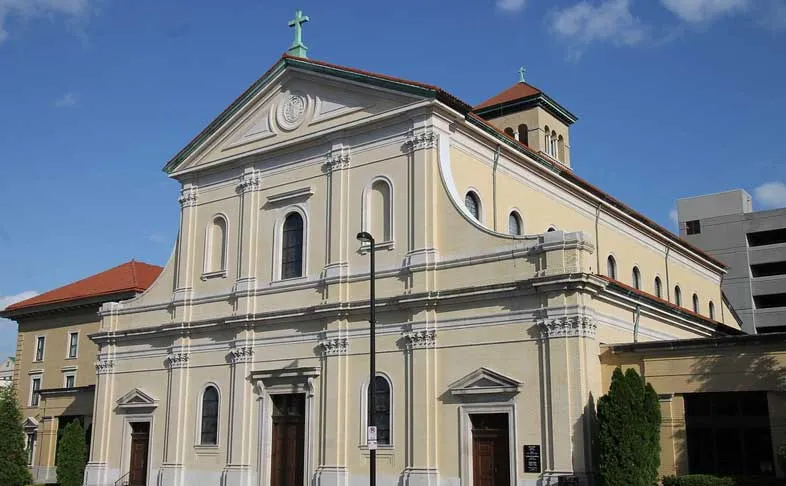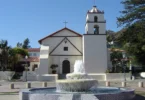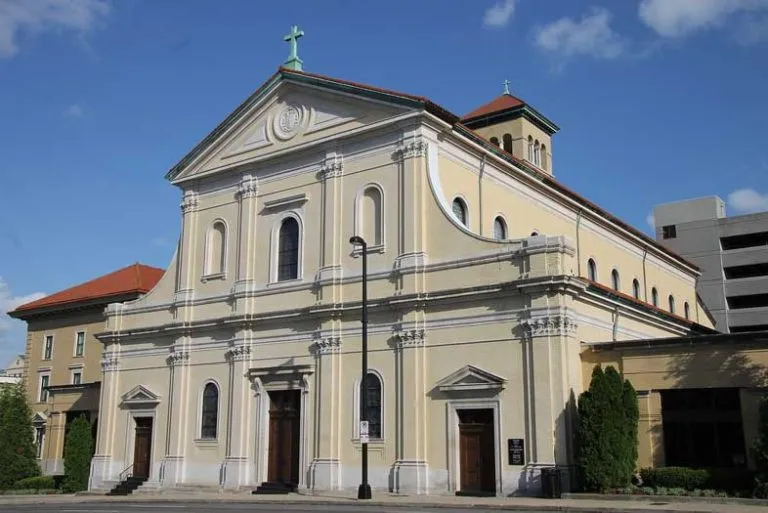
Introduction
The Cathedral of the Incarnation, Nashville located at 2015 West End Avenue in Nashville, is the cathedral seat of the Roman Catholic Diocese of Nashville. It is named after the Feast of the Incarnation, which commemorates the miraculous conception of Jesus in the womb of the Virgin Mary.
There have been three cathedral churches in Nashville. The first was the Holy Rosary Cathedral which is now demolished and occupied the site of what is now the Tennessee State Capitol. The second was Saint Mary’s Cathedral, which still stands on the corner of Fifth and Church Streets.
Construction of the Cathedral of the Incarnation began in 1910 under the direction of Bishop Thomas Sebastian Byrne. It was completed and dedicated July 26, 1914. The church has undergone three major renovations, one in 1937, another in 1987, and the most recent which began in March 2019. The 1987 renovation was supervised by Father Richard S. Vosko, a liturgical design consultant and priest of the Diocese of Albany who has overseen the redesign and renovation of numerous churches and cathedrals around the country.
The 2019 renovation was began by Father Edward Steiner and is being completed by Father Eric Fowlkes. The church’s architecture is modeled after the traditional Roman basilica, specifically the basilica San Martino ai Monti in Rome. The primary architect was Fred Asmus.
A traditional symbol for the resurrection which is sometimes called the eighth day of creation is the octagon shape which is seen in the baptismal pool. The main use of this pool is for the baptism of persons entering the church who have never been baptized which is done during the Easter Vigil.
The Paschal Candle (Easter Candle) is blessed at the Easter Vigil and symbolizes the resurrection of Christ. Referred to as the light of Christ the candle is lit during the Easter season for every liturgical event and during the year for every baptism. The newly baptized are presented with a smaller candle lit from the Paschal candle during the baptismal rite.
Lining the long side walls is a depiction of the Via Dolorosa or the Stations of the Cross. The series of images depicts events experienced by Jesus from his arrest to his Crucifixion. The stations were developed from the Via Dolorosa which is believed to be the actual path Jesus walked. Carved from terracotta bas-relief with full figures in ornate Renaissance framing between pilasters on the interior walls these add the right amount of decoration needed.
Without a doubt the main ceiling is the central focal point of the Cathedral’s interior. The coffered texture is believed to be the first of its kind in the United States made from an ornamental cement plaster called scagliola, which has the appearance of marble but is much lighter in weight.
The ceiling is held in place by 22 iron pillars which have been covered with scagliola and marbleized giving a majestic appearance. The coffered ceiling allowed for extensive architectural and stencil design with a 3D grid adding to the dignified and extravagant design. Examining the detail of the design the symbols in the north-end of the nave are associated with the death of Jesus, while the south-end near the sanctuary has symbols pertaining to His birth as the Incarnation of God.
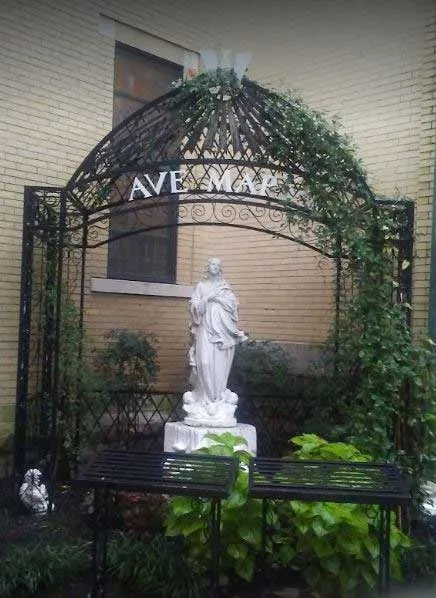
Some of the symbols which you will see are the Greek letters Alpha and Omega (beginning and end). There is a pair of dice (used to cast lots for Jesus’s clothing), a shepherd’s crook with a cross, a crown of thorns with three nails and many other symbols. With the hand painted symbols, designs and symmetry in the plaster relief along with the inspiring colors the ceiling remains a treasure of the Cathedral which is breath taking upon entering the church.
The twenty clerestory windows were made of art glass by the Louisville Art Glass Company which includes blue Flashed Glass, hand blown in France. Also, there is drawn antique lead crystal glass, a clear glass which forms a checkerboard effect.
The other colors in the flora patterns were created using a glass paint. On a sunny day, prisms on the west windows cast rainbow effects throughout the Cathedral. The lower part of these windows can be opened by a wheel in the choir loft. The clerestory windows were designed not only to provide light but to help focus one’s attention on the sanctuary at the south end of the building.
The wooden pews in the church were made from white oak in Jackson, Tennessee. They are part of the original furnishings and have been in the church since 1914. A Celtic cross was engraved on the end of each pew. All of the hardware throughout the church is solid brass including the large candlesticks around the altar.
The aspe is curved to make an emphatic relief from basilica boxiness to stress the importance of the central feature of every Catholic church, the main altar. The entire interior evolves into the apse, with bas-reliefs above and below flanking the curves, and splendid angels flanking the big arch. Directly above the white marble Crucifixions scene, you will see a painting depicting God the creator giving a blessing while holding the world.
Signor B. Mellerio did the paintings on canvas which were later attached to the dome of the aspe. The beauty of these paintings helps draw the attention of the people to the sanctuary. Flanking the dome of the apse the words “AVE REX” (Hail to the King) is painted. Framing the apse are large sculptures which are depictions of the four evangelists: John and Matthew to the east side with Mark and Luke to the west.
These sculptures are full of symbolism taken from the Old and New Testaments, particularly the books of Ezekiel and Revelation. St. John is associated with the symbol of the eagle because of his lofty theological flights in the Gospel. St. Matthew is associated with the face of man because in his Gospel he firmly establishes the human nature of Jesus. The symbol of the ox is associated with St. Luke due to his Gospel emphasizing the theme of sacrifice.
St. Mark is associated with the symbol of the lion because he begins his Gospel with the ministry of John the Baptist-the voice of one crying out in the wilderness. Three areas of the sanctuary are of primary liturgical importance: the altar (where Mass is celebrated), the cathedra (the chair of the Bishop of Nashville), and the ambo (pulpit) from which the Word of God is proclaimed.
The altar is one of the most important symbols for the presence of Christ in a Roman Catholic Church.
History of the Cathedral of the Incarnation
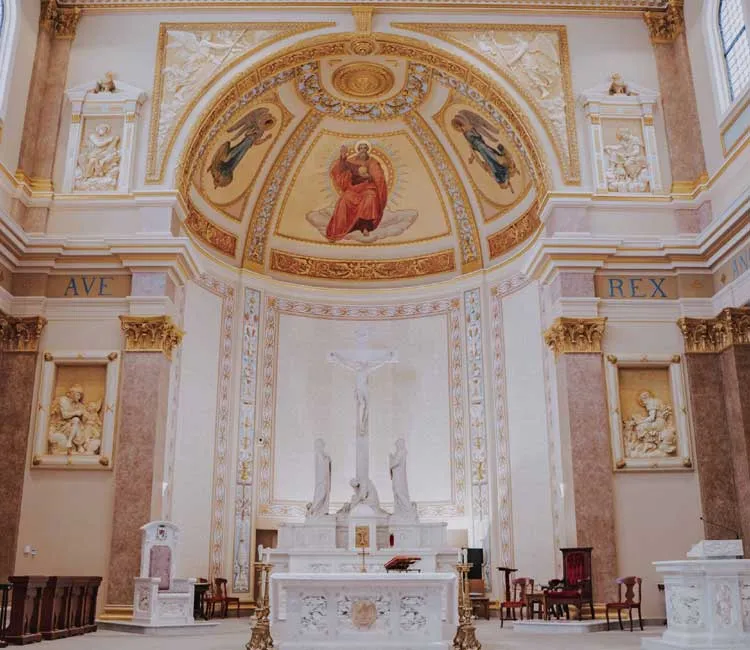
Cathedral of the Incarnation, Nashville – The Blessed Sacrament is kept in the marble tabernacle on the reredos altar. The word tabernacle means “little tent” since the Israelites use to carry the “Holy of Holies” in a tent. Throughout history this name has been maintained as the place where the Blessed Sacrament is stored. The candle next to the tabernacle serves as a signal that the Blessed Sacrament is present in the tabernacle when lit.
The free-standing main altar (altar of sacrifice) has the ancient Eucharistic symbol of the pelican feeding her young. It is hand-carved in translucent calcite alabaster on a field of book matched, brecciated Versilia marble. In the 2nd century it was told that the pelican would cut open her own breast with her beak and feed its young with its own blood if there wasn’t enough food. It became a symbol of Christ sacrificing Himself for man and a major symbol of self-sacrifice and charity. The pose of the mother bird is known as “the pelican in her piety.”
The white Carrara marble in the altar, ambo, and cathedral, is a perfect match to the white Carrara marble used in the crucifixion scene and the reredos altar. It came from the same marble quarry in Carrara, Italy.
The name “Cathedral” is derived from the Greek “cathedra” which means “chair.” The cathedra is the established seat of the bishop in the mother church of the diocese. This chair is the symbol of the bishop’s authority and from this seat wearing his miter and holding the crosier (pastoral staff) he is both teacher and pastor who will guide the journey of the faithful in faith, hope, and charity. The back of the chair has the coat-of-arms of Bishop Mark Spalding, our current bishop.
The Empire style chairs on the altar are from the original 1914 furnishings which were a gift to Bishop Byrne by Archbishop John Murphy Farley of New York. Our presider’s chair is made of rich walnut and was the original Cathedra which was used by Bishop Byrne.
Relics placed inside an altar come from an early tradition when mass was celebrated in underground catacombs. The altar was usually a stone placed on the bones of the martyrs. In the 3rd century when mass was moved above ground to buildings a relic was placed on the altar for reverence and to serve as a reminder about the holy lives and their sacrifice which was endured out of love for Christ.
The Cathedral is fortunate in having three first class relics (bones) in the sealed box inside the altar.
St. Athanasius the Great
He was bishop of Alexandria and a doctor of the church (title given to saints for their contribution to church theology or doctrine). He was exiled five times from Alexandria because of his faith. He wrote a thesis on the Incarnation.
St. Benignus
A priest who brought Christianity to Dijon France. He was arrested in Epagny, Burgundy, when he refused to deny Christ and make a sacrifice to pagan deities. The authorities tortured him and then clubbed him to death with a bar of iron and his heart was pierced.
St. Eulalia
A 13-year-old Roman girl who confronted the governor for his persecution of Christians in the reign of Emperor Diocletian. After 13 various tortures she would not deny her beliefs. She prayed that God would take her to Heaven then died. It is believed that she was torture on an X-shaped cross.
These relics were in the original altar in the Pro-Cathedral, where masses were held from 1909 to 1914. A second-class relic (part of a dress) was added to these relics later when a new altar was constructed. The dress belonged to St. Katherine Drexel (1858 to 1955) who founded the St. Vincent de Paul Parish for the purpose of ministering to the spiritual needs of African-American families in North Nashville and to the college students at Fisk University and Meharry Medical College.
On the east side of the sanctuary is the Annunciation chapel. The focal point of this chapel is the large relief of the Angel Gabriel talking to Mary at the annunciation. The three symbols on the ceiling are the white Lily also known as the Annunciation Lily which is a symbol of Mary’s immaculate purity. The crown with the symbols of Alpha and Omega showing the Blessed Virgin Mary as the queen of heaven throughout eternity. The Fleur-de-lis is an ancient symbol long connected with the Blessed Virgin Mary because of the purity she witnessed throughout her entire life.
The Fleur-de-Lis emphasizes life, light, and perfection, symbols of the Holy Trinity and the blessed mother. The chapel on the west side of the sanctuary is the Crucifixion Chapel. This chapel provides a quiet space for prayer with the focal point being a large wooden crucifix. Bishop Alphonse Smith commissioned this work of art while visiting Oberammergau in Bavaria, Germany, in 1930.
Oberammergau is the site of a large Benedictine Monastery and where the Passion Play is held every ten years. The symbols on the ceiling represent the torture Jesus endured on his way to the cross. The pillar and ropes symbolize the scourging of Jesus at the pillar. The spear, sponge, crown of thorns and cross reflect the agony and torture of Jesus during the crucifixion. The symbol of the Triumphant Lamb with the Book of the Seven Seals depicts the risen Jesus as the Lamb of God who was triumphant over death.
In the corner between the sanctuary and side chapels are marble stands containing blue candles. An ancient tradition of the church is to have vigil candles available to be lit by persons who have special prayer intentions. The smoke rising from the candle symbolizes the prayers rising to heaven. The terminology vigil has been used since the early church referencing the idea that you are keeping watch, praying and waiting for the answer to a prayer request.
From its dedication in 1914, the Cathedral of the Incarnation has stood as the elegant center of the Diocese of Nashville, Tennessee. The cathedral belongs to 70,000 Catholics of the diocese and serves as a place of ceremony and celebration. The Cathedral of the Incarnation is also a parish church and as such it is home to its parishioners and a welcoming place for all visitors.
Architecture
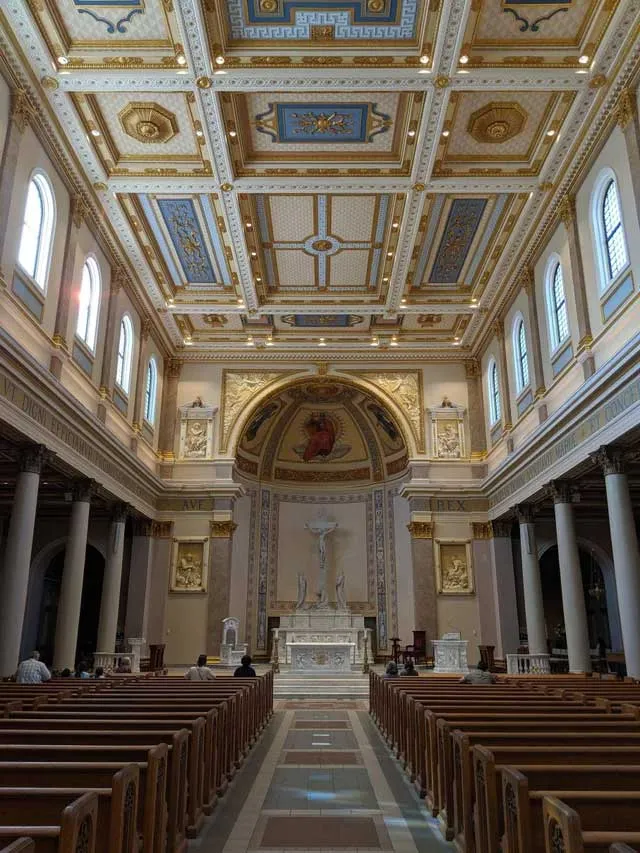
Architectural style : Italianate architecture
The facade is typical Italian Renaissance style in design showing many similarities with the Basilica of Santa Maria Novella in Florence. The central rectangle reflects the basic style of the church with the long nave flanked by side aisles of less than half the nave’s height. The rectangle is surmounted by a pediment containing a round stone entablature of Bishop Byrne’s coat-of arms and a simple bronze cross. Triangles with curved hypotenuses join the big rectangle to the smaller one-story ones for the side aisles.
The three entrances in the facade have pediments like those over the entrance to the residence and the pro-cathedral. Highlighting the elegance of this is the acanthus flower-like Corinthian capitals of the pilasters. The main triangle is decorated with four shallow niches with two being above and two flanking the main entrance. A fifth over the entrance is a stained-glass window of the Sacred Heart of Jesus image. The basilica-style architecture of the building with its yellow glazed brick and red Roman terracotta tile roof clearly makes this a spectacular work of art.
The campanile, bell tower, is modeled from the Romanesque bell tower of The Basilica of Santa Maria in Cosmedin, an ancient church in Rome. The bell tower was the first part of the church to be completed and is attached to the church. It rises 134 feet above the Cathedral and is 24 feet square. Arcaded cornices divide the square tower into five floors of mullioned windows which adds to the Italian charm.
The ornate interior of San Martino ai Monti (St. Martin’s on the Hill) in Rome was the inspiration which Bishop Byrne used to create his plans for the Cathedral of the Incarnation. The inside dimensions of the church proper are 175 feet by 96 feet. The Cathedral can comfortably seat 1,000 people. The interior of the Cathedral has the basic basilica design with a nave and two aisles, divided by columns which are holding up a clerestory level of twenty windows for light. The main altar with the Bishop’s Cathedra is also following the basilica style with the placement being at the far end across from the entrance.
The main entrance to the Cathedral is on West End Avenue with two smaller entrances on both corners of the south end of the building. The rectory is the building to the left and is fashioned after the Farnese Palace in Rome which is considered one of the wonders of Rome. To the right of the Cathedral is St. Albert Hall and the Father William J. Fleming Center.
From the main entrance you enter the narthex. At the east end is the vesting sacristy where the priest prepares to preside over Mass. On the west end is a door leading upstairs to the choir loft. In the choir loft is one of the handmade organs built by Henry Pilcher and Sons in Louisville, Kentucky in 1914. This is one of the 2000 organs Pilcher and Sons built between 1884 to 1944. The choir loft was designed and arranged so the musicians are not seen by the audience. Vocal and instrumental music flowing down from the unseen choir loft adds greatly to the ambience of the church service.
In the Narthex are Munich style stained glass windows showing the Annunciation and the birth of Jesus. These windows were designed by Franz Mayer of the Munich Company in Munich, Germany. The unique feature of these windows is from large glass panels which were painted and held in place by leaded framework. The result was elaborate detail which had a picture-like composition similar to a painting.
Directly in the center of the narthex is a window overlooking the baptismal font and pool. The window was designed after the famous Holy Spirit window in the Bernini Altar of St. Peter’s Basilica in Rome. The dove, symbol of the Holy Spirit, is made of opalescent glass. On each side of the baptismal font are life size marble statues of the Holy Family.
These were originally in the side chapels by the main altar. The Blessed Mother on the west side and a chapel for St. Joseph on the East side. In the 1937 renovation the statues were moved to the back of the church to stand next to the baptismal pool. It has been said that the placement of the statues at the baptismal font and pool serves as a welcome from the holy family to those entering the church. The baptismal font pre-dates the Cathedral of the Incarnation by approximately 10 years and was originally a part of St. Mary’s Cathedral. The font was designed and made by Senatori and Brugno in Rome.
The font is made of bronze and Pentellic marble and measures five and a half feet wide and with the lid of the font a total of nine feet high. The design is a scaled-down replica of the baptismal font designed by Michelangelo at St. Peter’s Basilica in Rome. The lid was removed in the 1987 renovation to make access to the basin easier. The font is used throughout the year primarily for the celebration of baptism of an infant. Catholics traditionally will place their fingers in the holy water and then make the sign of the cross to recall their entrance into the church and the Christian faith through baptism.
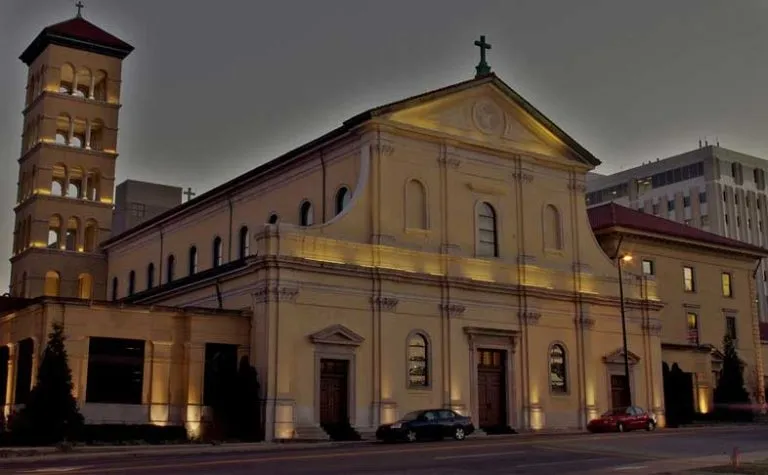
Feast Day – 25th March
The Annual Feast of the Annunciation (the Incarnation) on March 25th (9 months before Christmas, the gestation period Mary experienced) and then our dedication on July 26, which every Cathedral celebrates. The Pope’s cathedral does the same on the feast of Saint John Lateran.
Mass Time
Weekdays
Tuesdays to Fridays
Saturdays
Sundays
Church Visiting Time
Contact Info
Cathedral of the Incarnation,
2015, West End Ave, Nashville,
37203, Tennessee, TN, United States
Phone No.
Tel : +1 615-327-2330
Accommodations
How to reach the Cathedral
Nashville International Airport is the nearby airport to the Cathedral.
Riverfront Train Station is the nearby train station to the Cathedral.

